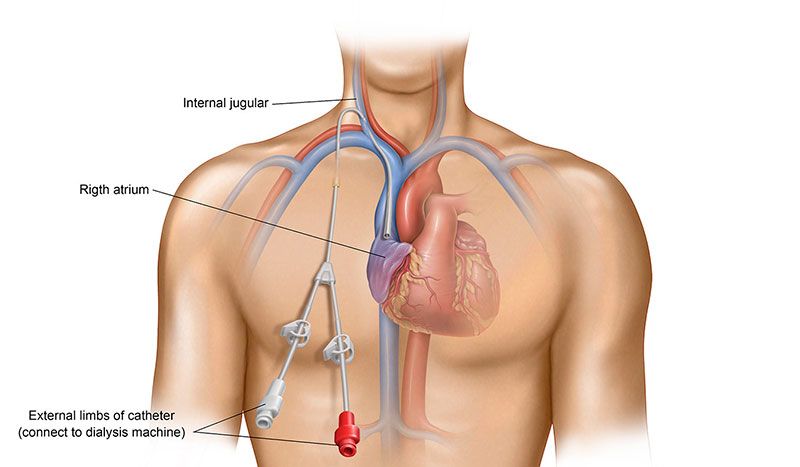Patients suffering from chronic kidney disease or renal failure need to under renal replacement therapy in the form of dialysis. Dialysis forms the lifeline of patients suffering from kidney disease. This dialysis can be performed either as hemodialysis (blood dialysis) or peritoneal dialysis (through the abdomen).
For hemodialysis, either a dialysis catheter is placed in one of the neck/ upper limb veins(subclavian vein) or even rarely in the leg veins in the groin, or an artificial joint is created between the artery and vein the upper limb, called as Arterio-Venous Fistula (or AVF for short).
There are three different types of dialysis access used for hemodialysis, a process in which blood is transported from your body for cleaning.
1) Central venous catheter (CVC)
2) Arteriovenous fistula (AV Fistula)
3) Arteriovenous graft (AV Graft)
4) Peritoneal dialysis catheter (PD Catheter)
1) Central Venous Catheter (CVC)
The first type of access we’ll look at is a central venous catheter (CVC), which is a flexible, long, plastic, y-shaped tube that is threaded through your skin into a central vein in your neck, chest, or groin. A CVC is not usually intended to be a permanent type of access. If you need immediate or emergency dialysis or cannot receive and don’t have an AV fistula or graft, you will require a CVC.
- Caring for Your CVC
If you have a CVC placed, you’ll need to learn to care for your catheter regardless of whether it’s permanent or temporary. Your physician will give you strict care instructions, so be sure to follow them.
2) AV Fistula
The second type of dialysis access is an AV fistula, which is an actual surgical connection made between an artery and a vein. An AV fistula is most often created in your non-dominate arm, but sometimes it can be created in your leg. This access results in an increased blood flow rate through the vein, which helps enlarge and strengthen the vein. An AV fistula allows a higher rate of blood to flow back and forth from your vein to a dialysis machine.
An AV fistula is the preferred access of all the types of hemodialysis access and is often referred to as the “gold standard.” In 2013, 65% of all patients in the United States Renal Data system were exclusively using an AV fistula at the end of one year of dialysis.
Once the AV fistula creation is complete, you will need to wait several months before it can be used so it can fully heal and mature.
3) AV Graft
The third type of access called an AV graft, functions similarly to an AV fistula. If you have blocked or damaged veins, or veins that are too small for a fistula, you may be a candidate for an AV graft. AV graft placement is also a surgical procedure, but instead of connecting the artery directly to the vein, one end of a small hollow, synthetic tube will be connected to your vein, and the other end will be connected to your artery.
Caring for Your AV Graft
Just like with an AV fistula, you will need to care for your graft every day, so remember to look, listen and feel for the same indicators used with a fistula.
4) PD Catheter
A PD catheter is used for peritoneal dialysis, which uses the lining of your belly and a Dialysis solution to clean your blood.
This type of dialysis can be a desirable method for people who are always on the go. With a PD catheter, dialysis can be performed at home and takes less time to accomplish.
If you are unable to care for yourself, have an abdominal hernia or inflammatory bowel disease, recurring diverticulitis, or large surgical scars on your belly, peritoneal dialysis and the PD catheter may not be an option for you.
Caring for Your PD Catheter
Having a PD catheter is associated with a high risk of infection in the lining of your belly, the tunnel that the catheter is threaded through, or in the site where the catheter exits your body.
As your catheter site heals, and when you are accessing the catheter for your prescribed peritoneal dialysis exchanges (or treatment), you’ll need to follow a strict sterile protocol.

